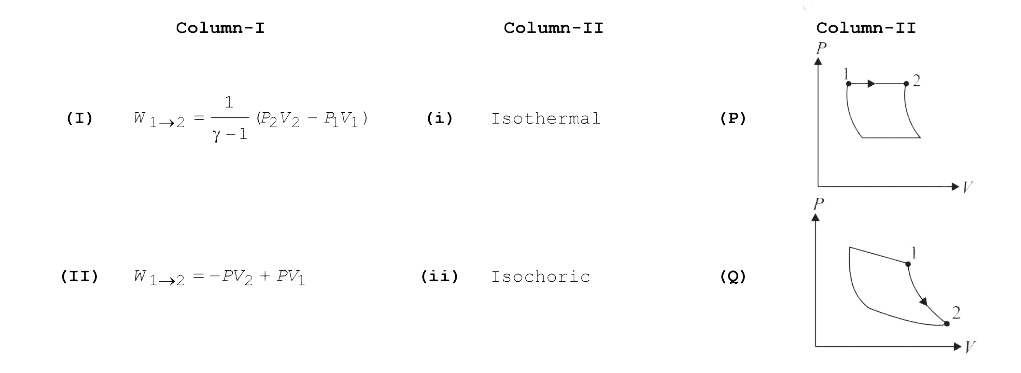Compare the formula Cp−Cv=R for an ideal gas with the thermodynamics relation ΔU=ΔQ−PΔV.
To compare the formula Cp−Cv=R for an ideal gas with the thermodynamic relation ΔU=ΔQ−PΔV, we can follow these steps:
Step 1: Understand the Definitions
- Cp is the specific heat at constant pressure.
- Cv is the specific heat at constant volume.
- R is the universal gas constant.
- ΔU is the change in internal energy.
- ΔQ is the heat added to the system.
- PΔV is the work done by the system during expansion or compression.
Hint: Recall the definitions of specific heats and the first law of thermodynamics.
Step 2: Apply the First Law of Thermodynamics
The first law of thermodynamics states:
ΔU=ΔQ−PΔV
Hint: This equation relates the change in internal energy to heat added and work done.
Step 3: Consider an Isobaric Process
For an isobaric process (constant pressure):
- The heat added can be expressed as:
ΔQ=nCpΔT
- The work done by the gas can be expressed as:
W=PΔV
Using the ideal gas law, we can express PΔV as:
PΔV=nRΔT
Hint: Remember that for an ideal gas, the relationship between pressure, volume, and temperature is given by the ideal gas law.
Step 4: Substitute into the First Law
Substituting these expressions into the first law of thermodynamics gives:
ΔU=nCpΔT−nRΔT
Hint: This substitution allows us to express the internal energy change in terms of specific heats and temperature change.
Step 5: Express Change in Internal Energy
The change in internal energy for an ideal gas can also be expressed as:
ΔU=nCvΔT
Hint: This is a fundamental property of ideal gases, where the change in internal energy depends only on the temperature change.
Step 6: Equate the Two Expressions for ΔU
Now, we can set the two expressions for ΔU equal to each other:
nCvΔT=nCpΔT−nRΔT
Hint: This step sets the internal energy expressions equal to each other.
Step 7: Simplify the Equation
Dividing through by nΔT (assuming ΔT≠0):
Cv=Cp−R
Step 8: Rearranging the Equation
Rearranging gives us the desired result:
Cp−Cv=R
Hint: This final rearrangement shows the relationship between the specific heats and the gas constant.
Conclusion
We have derived the relationship Cp−Cv=R from the first law of thermodynamics and the definitions of heat capacities for an ideal gas.
- Cp is the specific heat at constant pressure.
- Cv is the specific heat at constant volume.
- R is the universal gas constant.
- ΔU is the change in internal energy.
- ΔQ is the heat added to the system.
- PΔV is the work done by the system during expansion or compression.
The first law of thermodynamics states:
ΔU=ΔQ−PΔV
For an isobaric process (constant pressure):
- The heat added can be expressed as:
ΔQ=nCpΔT
- The work done by the gas can be expressed as:
W=PΔV
Using the ideal gas law, we can express PΔV as:
PΔV=nRΔT
Substituting these expressions into the first law of thermodynamics gives:
ΔU=nCpΔT−nRΔT
The change in internal energy for an ideal gas can also be expressed as:
ΔU=nCvΔT
Now, we can set the two expressions for ΔU equal to each other:
nCvΔT=nCpΔT−nRΔT
Dividing through by nΔT (assuming ΔT≠0):
Cv=Cp−R
Rearranging gives us the desired result:
Cp−Cv=R
We have derived the relationship Cp−Cv=R from the first law of thermodynamics and the definitions of heat capacities for an ideal gas.
Similar Questions
Knowledge Check
ΔHandΔU are related as
AΔU=ΔH+PΔVBΔH=ΔU−PΔVCΔH=PΔV−ΔUDΔH=ΔU+PΔVUnder which of the following conditions is the relation, ΔH=ΔE+PΔV valid for a system :-
AConstant pressureBConstant temperatureCConstant temperature and pressureDConstant temperature, pressure and compositionFor an ideal gas Cp and Cv are related as
ACp−Cv=RBCpCv=RCCp+Cv=RDCv−Cp=R
Cp−Cv=R and ideal gas
(δUδV)T=0 for an ideal gas .
View SolutionIf 1,w,w2 are cube roots of unity represented on the complex plane by the points A,B and C respectively. If P,Q and R are the centroids of ΔOAB,ΔOBC and ΔOAC respectively then the area of ΔPQR is
View SolutionDefienCp and Cv. How are these related for an ideal gas?
View SolutionAn ideal gas is undergoing a cyclic thermodynamic process in different ways as shown in the corresponding P-V diagrams in column 3 of the table. Consider only the path from state 1 to state 2. W denotes the corresponding work done on the system. The equations and plots in the table have standard notations as used in thermodynamic process. Here is the ratio of heat capacities at constant pressure and constant volume. The number of moles in the gas in n.


Which of the following options is the only correct representation of a process in which ΔU=ΔQ−PΔV?
View SolutionThe relation between U,P and V for an ideal gas in an adiabatic process is given by U = 2 + 3 PV. The gas is
View Solution
